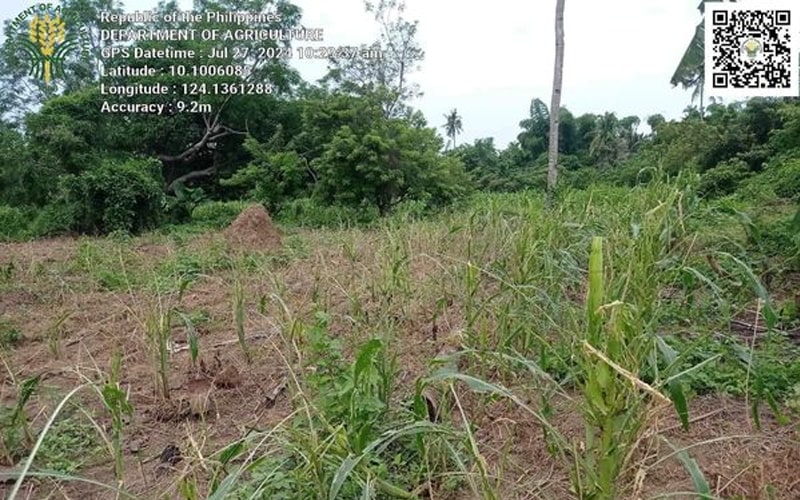
TAGBILARAN CITY, Bohol (PIA) –Metro Manila may have experienced one of its most devastating floods in recent years, but farmers in Getafe, Bohol and in several other areas are still hoping for the rains that may not happen anytime soon.
This as the cloud seeding team contracted by the Bureau of Water and Soil Management (BSWM) of the Department of Agriculture is completing its contract after completing the last of the 50 hours of rain-inducing flights anytime, according to Science Research Specialist II Cecile Opada.
The contract with the cloud seeding supplier ends by July 31, after which the team would fly out.
The statement also came after the cloud seeding Task Force temporarily suspended its operations in anticipation of the rains brought about by Tropical Storm Carina.
Data from the state weather bureau during the suspension showed that the rainfall track of Super Typhoon Carina from July 19 to 25, showed below 50 millimeters of rains in Bohol and the Visayas, compared to the more than 600 millimeters of rain dumped in Metro Manila and western parts of Luzon.
The six days suspension also had Mabini, Getafe, San Isidro, Buenavista, Balilihan farmers reporting no rains despite the typhoon alert.
We only have 3.35 hours of flight left from the 50 flights we got from the BSWM, this would be equivalent to 3 sorties, Opada said.
The cloud seeding operations in Bohol started in the second week of June, but by July 16, National Irrigation Administration has reported 46.12 percent increase in its initial targeted areas for irrigation.
For Local Government Units which take charge of operating small water irrigation systems, the artificial rains and the natural rains that fell spiked their irrigation targets to 1555% or from 602 to 9364 hectares.
Over-all however, despite the rains which PAG-ASA forecasted and the ones caused by the cloud seeding operations, this is just 25.28 percent of the 37,937 hectares of rain-fed areas.
Last July 17, Malinao Dam was spilling at 152.12 meters and was sharing its water to irrigators, but by July 27, the level has gone down to 150.44 meters by July 27, Bayongan Dam was at 46.31 meters in July 17 and shrunk to 46.20 meters by the 27th, Capayas Dam was at 32.77 meters on the 17th while it went 33.31 meters by the 27th and Zamora Dam of Talibon was at 28.41 meters on the 17th and rose to 29.30 meters by the 27th.
Benliw, on the other hand was at 30.87 meters which went to 31.21 meters by July 27; Ilaya Dam was at 56.25 meters went down to 55.20 meters by July 27 and Ilijan Dam at 39.86 meters in July 17 and 40.36 meters by the 27th.
In Getafe for example, farmers who raced in their farm preparation to catch up with the planting were left with dried beds or burnt seedlings, when the cloud seeding was suspended.
Those who also opted to plant corn instead due to lack of rains, had their plants growing off season that these were vulnerable to Fall Army Worm (FAW), reports Getafe Municipal Rice Technician, shared Opada.
Mabini also reported that the initial rains allowed them to prepare their land but without the rains falling recently, the fields have dried again, according to the reports.
Meanwhile, the Task Force still believes “The north of Bohol still needs more rainwater so that the farmers can initiate land preparation, and without the natural rains falling, several areas may still be damaged.”
With rains still falling elsewhere but in agricultural areas in Bohol, the Provincial Government is readying another P2.5M from its own disaster funds to bring in the much needed water for the farms.
According to Capitol sources, all documents leading to the continuation of the cloud seeding operation are set and ready, however it was not ascertained if a bidding is needed to identify suppliers of the operation, or if the go signal to proceed can happen while the cloud seeding team is still here in Bohol.
Pegasus officials said while they technically end the contract by July 31, they still have Civil Aviation Authority of the Philippines (CAAP) clearance until August 5, before they can fly out.
With few more days left before the cloud seeding team flies out, farmers can now look at the way the Office of Provincial Agriculture speeds up its process this time.
Observers said it might take another long time to request for another operations team and by then, fields would have dried up again. Unless the rains come steadily. (PIABohol)


